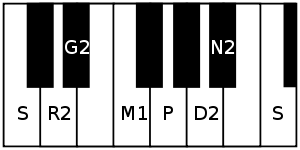Shree ragam
| Carnatic music |
|---|
Tanjavur-style Tambura |
| Concepts |
| Compositions |
| Instruments |
|
Shree ragam is an ancient ragam in the Carnatic tradition. It is also written as Sri or Shri.[1] This scale is a janya rāgam (derived scale), as it does not have all the seven swaras (musical notes) in the ascending scale.[1] Shree is a janya rāgam of Kharaharapriya, the 22nd Melakarta rāgam.[1][2] It is the last of the 5 Ghana rāgams of Carnatic music.[1] It is a pleasing and popular rāgam.[2] It is considered to be highly auspicious.
It is not related to the Hindustani raga, Shree. Notably, Carnatic Shree takes the lower madhyamam being a janya raga of Kharaharapriya.
Structure and Lakshana


Shree is an asymmetric rāgam that does not contain gāndhāram or dhaivatam in the ascending scale. It is a audava-vakra-sampurna rāgam (or owdava, meaning pentatonic in ascending scale),[1] where vakra indicates the zig-zag nature of jumping notes in descending scale. Its ārohaṇa-avarohaṇa structure (ascending and descending scale) is as follows (see swaras in Carnatic music for details on below notation and terms):
This scale uses the notes chatushruti rishabham, sadharana gandharam, shuddha madhyamam, panchamam, chatushruti dhaivatam and kaisiki nishadam.
Popular compositions
Shree rāgam has been decorated with compositions by many composers. A few of the popular kritis are listed here.
- The fifth Pancharatna Kriti Entaro mahanubhavulu composed by Tyagaraja, the last of the 5 gems
- Sami ninnekori, a Varnam by Karur Devudu Iyer
- Nama kumusumamula by Tyagaraja
- Sri Varalakshmi and Sri Kamalambikaye by Muthuswami Dikshitar
- Karuna judu ninnu by Shyama Shastri
- Mangalam arul by Papanasam Sivan
- Vande Vasudevam by Annamacharya
Related rāgams
This section covers the theoretical and scientific aspect of this rāgam.
Scale similarities
- Madhyamavati is a rāgam which has a symmetric ascending and descending scale, which matches the ascending scale of Shree. Its ārohaṇa-avarohaṇa structure is S R2 M1 P N2 S : S N2 P M1 R2 S
- Manirangu is a rāgam which has gāndhāram in the descending scale, while all other notes in both the ascending and descending scale are same as Madhyamavati. Its ārohaṇa-avarohaṇa structure is S R2 M1 P N2 S : S N2 P M1 G2 R2 S
References
- 1 2 3 4 5 Ragas in Carnatic music by Dr. S. Bhagyalekshmy, Pub. 1990, CBH Publications
- 1 2 Raganidhi by P. Subba Rao, Pub. 1964, The Music Academy of Madras